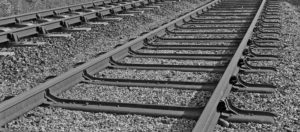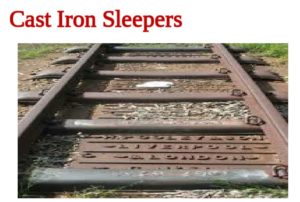
Railroad sleepers are traditionally made of wood, but pre-stressed concrete is now also widely used, especially in Europe and Asia. Steel ties are common on secondary lines in the UK; plastic composite ties are also employed, although far less than wood or concrete. As of January 2008, the approximate market share in North America for traditional and wood ties was 91.5%, the remainder being concrete, steel, azobé (red ironwood) and plastic composite. Approximately 3,520 wooden crossties are used per mile of mainline railroad track in the US (distance between ties is nominally 18″ including one tie and the crib), 2,640 per mile (30 per 60 ft rail) on main lines in the UK. Rails in the US may be fastened to the tie by a railroad spike; iron/steel baseplates screwed to the tie and secured to the rail by a proprietary fastening system such as a Vossloh or Pandrol are commonly used in Europe.
.
Types of Sleepers
1. Wooden Sleepers
These are commonly 254mm wide by 127mm thick in cross section by 2600 mm long. The sleepers are first seasoned (drying for up to 12 months so that to remove the juice/sap) and treated with preservative. Creosote is an oil generally used/ sprayed on the surface. They are either hard wood or soft wood type. Wooden sleepers are the ideal type of sleeper. Hence they are universally used. The utility of timber sleepers has not diminished due to the passage of time.
Advantages of Wooden Sleepers
- They are cheap and easy to manufacture
- They are easy to handle without damage
- They are more suitable for all types of ballast
- They absorb shocks and vibrations better than other types of sleepers.
- Ideal for track circuited sections
- Fittings are few and simple in design
- Good resilience
- Ease of handling
- Adaptability to non standard situation
- Electrical insulation
Disadvantages of Wooden Sleepers
- They are easily liable to attack by vermin and weather
- They are susceptible to fire
- It is difficult to maintain gauge in case of wooden sleepers
- Scrap value is negligible
- Their useful life is short about 12 to 15 years.


2. Steel Sleepers
- Steel ties are used where wood or concrete is not favorable, for example in tunnels with limited headway clearance
- They are also used in heavy curvature prone to gage widening.
- This type of steel ties can cause problem to signals control system
- Some problem of fatigue cracking have also experienced.
- Due to the increasing shortage of timber in the country and other economic factors have led to the use of steel and concrete sleepers on railways.
Advantages of Steel Sleepers
- It is more durable. Its life is about 35 years
- Lesser damage during handling and transport
- It is not susceptible to vermin attack
- It is not susceptible to fire
- Its scrap value is very good
Disadvantages of Steel Sleepers
- It is liable to corrosion.
- Not suitable for track circuiting
- It can be used only for rails for which it is manufactured
- Cracks at rail seats develop during the service.
- Fittings required are greater in number


3. Cast Iron Railway Sleepers
They are further divided into two categories:
- Cast iron pot type sleepers
- Cast iron plate type sleepers
Advantages of Cast Iron Sleepers
- Service life is very long
- Less liable to corrosion
- Form good track for light traffic up to 110 kmph as they form rigid track subjected to vibrations under moving loads without any damping
- Scrap value is high
Disadvantages of Cast Iron Sleepers
- Gauge maintenance is difficult as tie bars get bent up
- Not suitable for circuited track
- Need large number of fittings
- Suitable only for stone ballast
- Heavy traffic and high speeds (>110kmph) will cause loosening of keys and development of high creep

4. Concrete Railway Sleepers
They have design life of up to 40 years. They can easily be moulded into the required/design shape to withstand stresses induced by fast and heavy traffic. Reinforced Concrete and prestressed concrete sleepers are now replacing other types of sleepers except in some special circumstances like bridges etc. where wooden sleepers are used. Concrete sleepers may be of two types:
- Mono Block Concrete Sleepers
- TWIN BLOCK Concrete sleepers
Advantages of Concrete Sleepers
- It is more durable having greater life (up to 50years)
- It is economical as compare to wood and steel.
- Easy to manufacture.
- It is not susceptible to vermin attack
- It is not susceptible to fire
- Good for track circuited areas
Disadvantages of Concrete Sleepers
- It is brittle and cracks without warning.
- It cannot be repaired, and required replacement.
- Fittings required are greater in number.
- No scrap value




